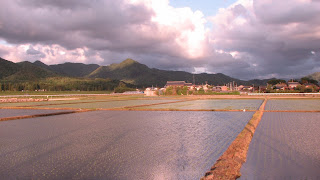This first one is taken from the slopes of Tosakayama (鳥坂山), or "bird slope mountain." The mountain was well named, as the hike up was more vertical than anything. These are the rice fields in the Kurokawa river valley, leading back towards the Tainai ski area:

On the same hike, I ran into a tamamushi (玉虫: lit. "round bug") at the summit. I don't know why it's called "round," as it's obviously not, but the term tamamushiiro, meaning "tamamushi-colored" can mean either iridescent or ambiguous (click image to enlarge):

This is a rice field just at planting time. I stopped and took the picture on my way to visit a friend in Murakami. The fields didn't have any rice growing in them just yet, so the whole coastal plain from the Sea of Japan to the mountains was a massive, watery quilt:

This picture was taken from the deck of my apartment: a storm gathering over the mountains. Most of the storms that actually amount to anything seem to form over the sea; this one petered out shortly after taking the picture.

Patches of cloud and sunshine over the rice fields just north of my house. The green speckles on the fields are the newly planted rice seedlings.

A close-up of the newly planted rice, with evening clouds reflected in the water.

This is an unremarkable photograph with a bit of interesting history- according to a sign, this feux-oil well stands on the sight of the oldest oil well in Japan, operational about 600 years ago. The next-door town takes its eponym from the actual kurokawa (黒川: "black river") next door, which in turn got its name from oil naturally leaking into the river in ancient times. Before wells were constructed, people would harvest the oil by dipping brushy branches into the river, after which the adhering oil was scraped off into a bucket.

One of numerous Christian signs that hang around the prefecture, and I think perhaps all of Japan. The signs usually carry some simple slogan, and then simply cite "Jesus," or "The Bible," leaving specific notation out of it. This one says something to the effect of "The blood of Jesus cleanses of sin. -The Bible" Christianity's long, strange relationship with Japan hasn't shown itself to me much since I've been here, although I do see the occasional church or cross. Any outward expressions of faith seem to be limited to austere, black and yellow signs such as this one:

I took some friends on a trip to Hagurosan, partly because I wanted to see it again, and partly because such things are better shared with company. On the way up, we stopped at a small salt-making shop in Sasagawanagare, the ludicrously scenic coastal strip north of Murakami. This man seemed pretty unexcited or disappointed about having customers either way, and just went about his business making salt. I did managed to get out of him that the salt takes about 10 hours over heat to crystallize out of the water. The facility was full of rusty surfaces, steam, and little bit of salt crystal clinging to the various fixtures:

Here is the main torii at the pilgrim's gate to the mountaintop shrine at Hagurosan I just included this photo because I liked it, and feel like it captures some of the mystique of the mountain. I won't go into detail because I've already been here once, and you can read that post here.

That's all for the random pictures post, I hope it was enjoyable. What's next will likely come after this weekend, when I will be attending a fighting kite festival. Until that time, yoroshiku, onegaishimasu
No comments:
Post a Comment